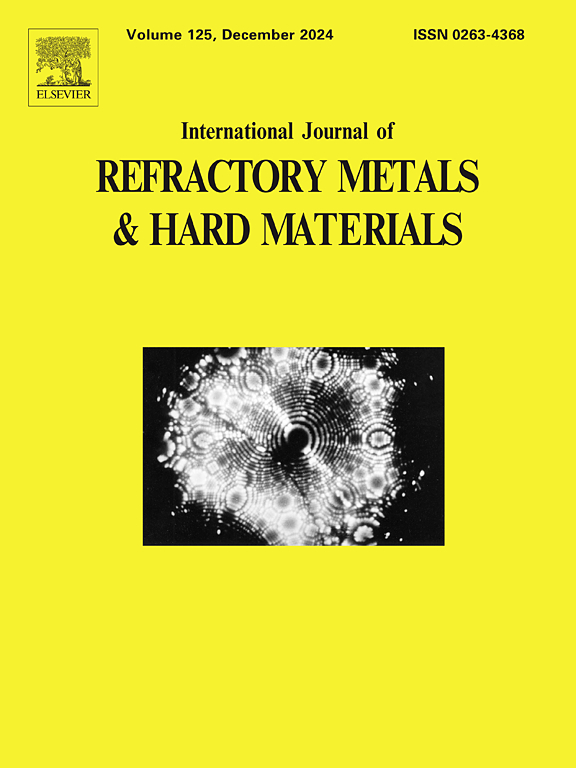Effects of Zr addition on the microstructure and mechanical properties of Y-Zr-O complex oxide dispersion-strengthened Mo alloys
IF 4.2
2区 材料科学
Q2 MATERIALS SCIENCE, MULTIDISCIPLINARY
International Journal of Refractory Metals & Hard Materials
Pub Date : 2024-11-06
DOI:10.1016/j.ijrmhm.2024.106953
引用次数: 0
Abstract
Y-Zr-O complex oxide dispersion-strengthened Mo alloys with different Zr contents (Mo-2Y2O3–0.6Zr, Mo-1Y2O3–0.6Zr, and Mo-1Y2O3–1.2Zr, wt%) were designed and fabricated by mechanical alloying and spark plasma sintering to investigate the effect of Zr addition on the microstructure and mechanical properties of this Mo alloy. The size and spatial distribution of oxide particles were characterized using Fresnel contrast mode in TEM, and mechanical properties were measured using small-scale three-point bending tests. Results show that Zr addition leads to the coarsening of oxide particles, especially intergranular particles. Based on Weibull theory, the strength ratio of Mo alloys in three-point bending and tensile tests is well fitted as 1.70. Furthermore, the Mo-2Y2O3–0.6Zr alloy exhibits an unprecedented tensile strength and fracture strain of 1059 MPa and 1.01 %, attributed to its ultrafine Mo grains (∼0.3 μm), semi-coherent intragranular oxide nanoprecipitates (∼18.09 nm), and intergranular oxide nanoprecipitates (∼67.11 nm). The theoretical calculation indicates that the strength is mainly affected by grain boundary strengthening and intragranular particle strengthening. The findings can provide a beneficial reference for the relationship between microstructure and mechanical properties of high-performance Mo alloy for nuclear energy applications.
添加 Zr 对 Y-Zr-O 复合氧化物分散强化钼合金微观结构和力学性能的影响
设计并通过机械合金化和火花等离子烧结制造了不同 Zr 含量的 Y-Zr-O 复合氧化物分散强化钼合金(Mo-2Y2O3-0.6Zr、Mo-1Y2O3-0.6Zr 和 Mo-1Y2O3-1.2Zr,wt%),以研究添加 Zr 对该钼合金微观结构和力学性能的影响。利用 TEM 中的菲涅尔对比模式对氧化物颗粒的尺寸和空间分布进行了表征,并利用小尺寸三点弯曲试验对力学性能进行了测量。结果表明,添加 Zr 会导致氧化物颗粒变粗,尤其是晶间颗粒。根据 Weibull 理论,Mo 合金在三点弯曲和拉伸试验中的强度比为 1.70,拟合良好。此外,Mo-2Y2O3-0.6Zr 合金的抗拉强度和断裂应变达到了前所未有的 1059 兆帕和 1.01%,这归功于其超细 Mo 晶粒(∼ 0.3 μm)、半连贯的晶粒内氧化物纳米沉淀(∼ 18.09 nm)和晶粒间氧化物纳米沉淀(∼ 67.11 nm)。理论计算表明,强度主要受晶界强化和晶粒内颗粒强化的影响。该研究结果可为核能用高性能钼合金的微观结构与力学性能之间的关系提供有益的参考。
本文章由计算机程序翻译,如有差异,请以英文原文为准。
求助全文
约1分钟内获得全文
求助全文
来源期刊
CiteScore
7.00
自引率
13.90%
发文量
236
审稿时长
35 days
期刊介绍:
The International Journal of Refractory Metals and Hard Materials (IJRMHM) publishes original research articles concerned with all aspects of refractory metals and hard materials. Refractory metals are defined as metals with melting points higher than 1800 °C. These are tungsten, molybdenum, chromium, tantalum, niobium, hafnium, and rhenium, as well as many compounds and alloys based thereupon. Hard materials that are included in the scope of this journal are defined as materials with hardness values higher than 1000 kg/mm2, primarily intended for applications as manufacturing tools or wear resistant components in mechanical systems. Thus they encompass carbides, nitrides and borides of metals, and related compounds. A special focus of this journal is put on the family of hardmetals, which is also known as cemented tungsten carbide, and cermets which are based on titanium carbide and carbonitrides with or without a metal binder. Ceramics and superhard materials including diamond and cubic boron nitride may also be accepted provided the subject material is presented as hard materials as defined above.

 求助内容:
求助内容: 应助结果提醒方式:
应助结果提醒方式:


